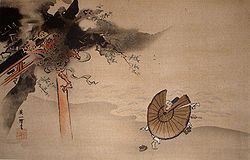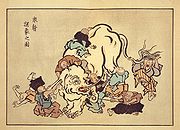
Hanabusa Itcho
Encyclopedia


was a Japanese painter, calligrapher, and haiku
Haiku
' , plural haiku, is a very short form of Japanese poetry typically characterised by three qualities:* The essence of haiku is "cutting"...
poet. He originally trained in the Kanō style
Kano school
The ' is one of the most famous schools of Japanese painting. The Kanō school of painting was the dominant style of painting until the Meiji period.It was founded by Kanō Masanobu , a contemporary of Sesshū and student of Shūbun...
, under Kanō Yasunobu, but ultimately rejected that style and became a literati (bunjin). He was also known as Hishikawa Waō and by a number of other art-name
Art-name
An art-name is a pseudonym, or penname, used by an East Asian artist, which they sometimes change. The word and the idea to use a pseudonym originated from China, then became popular in other East Asian countries ....
s.
Born in Osaka
Osaka
is a city in the Kansai region of Japan's main island of Honshu, a designated city under the Local Autonomy Law, the capital city of Osaka Prefecture and also the biggest part of Keihanshin area, which is represented by three major cities of Japan, Kyoto, Osaka and Kobe...
, and the son of a physician, he was originally named Taga Shinkō. He studied Kanō painting, but soon abandoned the school and his master to form his own style, which would come to be known as the Hanabusa school.
He was exiled in 1698, for parodying one of the shogun's concubines in painting, to the island of Miyakejima
Miyakejima
is an island in the Izu group, southeast of Honshū, Japan, administered by the Tokyo Metropolitan government, with an area of 55.50 km². The island, 180 km south of Tokyo, is located at 34.5N and 139.34E. As of January 1, 2006, the population of the island is 2884...
; he would not return until 1710. That year, in Edo
Edo
, also romanized as Yedo or Yeddo, is the former name of the Japanese capital Tokyo, and was the seat of power for the Tokugawa shogunate which ruled Japan from 1603 to 1868...
, the artist would formally take the name Hanabusa Itchō.
Most of his paintings depicted typical urban life in Edo, and were approached from the perspective of a literati painter. His style, in-between the Kanō and ukiyo-e
Ukiyo-e
' is a genre of Japanese woodblock prints and paintings produced between the 17th and the 20th centuries, featuring motifs of landscapes, tales from history, the theatre, and pleasure quarters...
, is said to have been "more poetic and less formalistic than the Kanō school, and typical of the 'bourgeois' spirit of the Genroku
Genroku
was a after Jōkyō and before Hōei. This period spanned the years from September 1688 through March 1704. The reigning emperor was .The years of Genroku are generally considered to be the Golden Age of the Edo Period. The previous hundred years of peace and seclusion in Japan had created relative...
period".
Hanabusa studied poetry under the master Matsuo Bashō
Matsuo Basho
, born , then , was the most famous poet of the Edo period in Japan. During his lifetime, Bashō was recognized for his works in the collaborative haikai no renga form; today, after centuries of commentary, he is recognized as a master of brief and clear haiku...
, and is said to have been an excellent calligrapher as well.
See also
- Hanabusa Itchō IIHanabusa Itcho IIHanabusa Itchō II was the son and pupil of Japanese painter Hanabusa Itchō. He was also known as Hanabusa Taga, Nobukatsu, Chōhachi, and Mohachi.-References:...
- son and pupil of Itchō - nanga - "literati painting"

